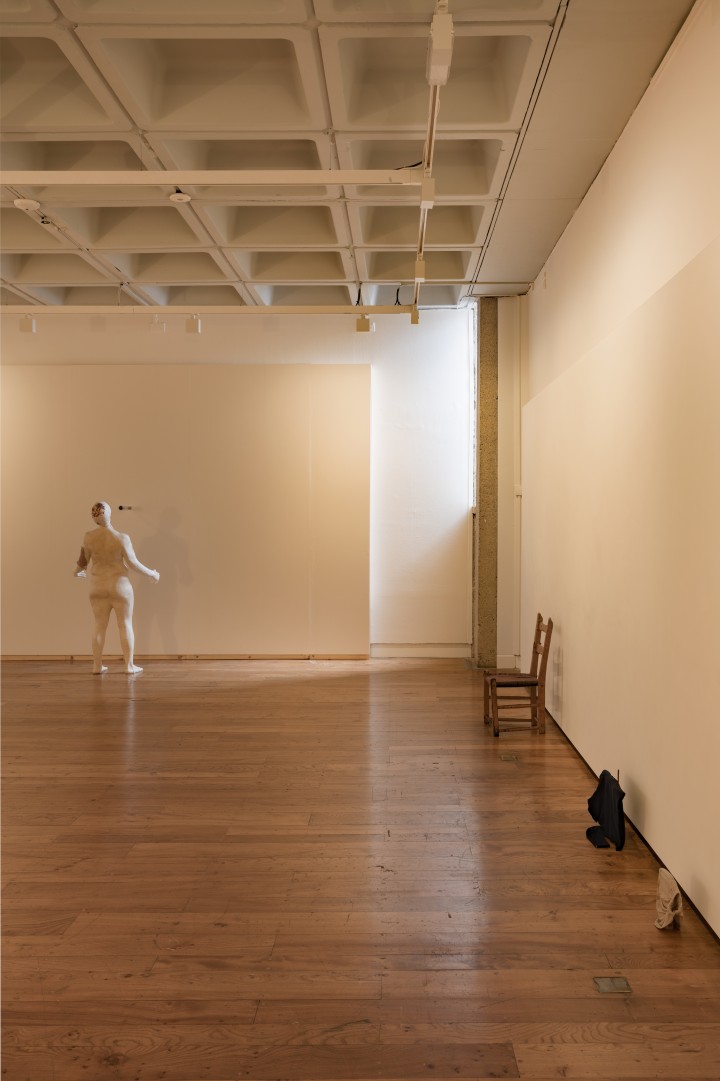Scottish Art News
Latest news
Magazine
News & Press
Publications
Review: Cathy Wilkes
By Greg Thomas, 08.07.2024
.jpg)
At the centre of Cathy Wilkes’ new exhibition at the Hunterian is the story of Emma Groves, a Belfast mother of 11, shot in the face with a rubber bullet after she disobeyed the orders of the British paratroopers searching her street. Groves had been playing a nationalist folk song, ‘The Four Green Fields’, in defiance of a British Army neighbourhood search. She was told to close her window. She refused and was blinded for life.
 Hunterian Gallery install, image courtesy of the Hunterian Gallery
Hunterian Gallery install, image courtesy of the Hunterian Gallery
Cathy Wilkes (herself a native of Belfast, born to a Protestant family in Dundonald in 1966, five years before the attack on Groves) is not an artist predisposed to extensive exposition. This new show, realised through the Imperial War Museum’s 14–18 NOW Legacy Fund, consists of entirely untitled works, and there’s not a wall- text in sight. But we can piece together from the materials gathered in vitrines that Groves is the likely subject of the central sculptural piece. A layered-paper cast of a middle-aged female form, sheets fraying at the fingertips, stands facing a wall with her head, shoulders, neck and torso bending painfully backwards, as if recoiling from a blow. Inches from her face is a rubber bullet, suspended in a transparent plastic tube emerging from a neatly drilled hole in the wall. The face and crown of the head are patterned ochre and red with collaged fragments of paper, suggesting blood or sites of traumatic impact.
This is the gesture – breathtaking, viscerally affective – around which the exhibition coheres, from which other works seem to emerge, like echoes or acts of remembrance. It represents a stunningly direct statement for an artist whose practice has, over recent years, seemed to recede into shadowy, albeit captivating, abstraction. Wilkes’ last two shows in Glasgow, held at the Modern Institute in 2021 and 2023, consisted primarily of paintings in pigment and gum Arabic that barely touched the surface of the fabric or linen on which they were composed. The former exhibition also included translucent fabric and wire sculptures. To be sure, hints of figurative detail abounded in these pieces: suggestions of torsos, limbs, domestic objects (the mis-en-scene of the feminised home is a recurring theme of Wilkes). But no sooner had the suggestion lodged itself than it seemed to flit away, and with it any biographical traces or social commentary bound up with it.
Here we have, as it were, a peg on which to hang more specific inferences of context and content. Moreover, the space in which the Groves-like figure stands has been minimally furnished to suggest a working-class 1970s living room, with humdrum flower-patterned sconce lamps, a tatty wooden chair, and what looks like a child’s jacket and satchel hanging on pegs in the adjoining corridor. Violence, it seems, has invaded the home: banal, quotidian violence, and the ongoing, underlying threat of violence that colonises the mind like a dull pain. This is the violence that weaved itself through the lives of women and girls growing up in Belfast in the 1970s and 80s (analogies with Maria Fusco’s recent film History of The Present are too striking not to mention in passing).
In the aforementioned vitrines, is a selection of booklets, pamphlets, placards and other archival ephemera that roots the collection of works still more clearly in the Belfast of the Troubles. There is a hastily drawn-up poster reading ‘Stop RUC Brutality’, magazine photos of living rooms damaged by military assaults, and an article from Socialist Woman showing Groves’ horribly bruised face below the headline ‘How British troops “keep the peace”’.
 (1).jpg) Untitled, 2014, image courtesy of Patrick Jameson and the Artist
Untitled, 2014, image courtesy of Patrick Jameson and the Artist
The remainder of this exhibition consists mainly of paintings, some created through rudimentary transfer techniques. Painted surfaces have been pressed to the canvas with the artist’s fingers; string has been dipped in paint and flicked or draped across it. There’s an all-at-once-ness to these modes of composition that makes the resultant works imprints of single moments in time. Allusions to the moment of violence depicted elsewhere in the exhibition are more bound up in the process than the resultant images; as though these pieces arose from the repetitive spasming of memory, returning the mind over and over again to the earlier, catastrophic moment represented by the sculpture. One such painting seems spattered with blood-red, leaning towards a more representational effect.
The other binding image across these paintings is that of the candle. The shape is built up in most cases through repeated squares of mottled paint transfer, and in one case using offcuts of fabric probably belonging to the artist (one scrap has been taken from the inside of a pocket, and still has lint and crumbs on it). There is an illustratively Catholic quality to the candle motif that is noteworthy given Wilkes’s own perspective on the events explored. Perhaps there’s a similar quality to the various accompanying sculptural works consisting of sheets and fabrics of various sizes draped over rectangular mounts, suggesting children’s clothing, the blankets used by IRA hunger strikers to conceal their prison clothes, or, possibly, veiled icons.
If Wilkes’ more abstract two-dimensional works, furnished by the context of Groves’ story, suggest the aftershocks of violence, her candle paintings speak to themes of healing, ritual, acts of peaceful communion. This is a show that brilliantly and devastatingly suggests the ongoing psychological impact of brutality while pointing towards the possible conditions of healing through shared ritual.
Cathy Wilkes’ work is exhibited at The Hunterian, Glasgow, until 19th September




